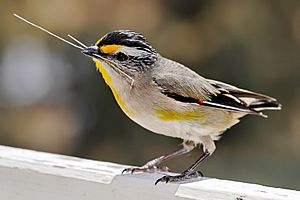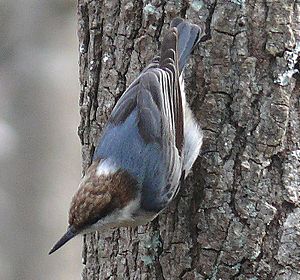Passerine facts for kids
Quick facts for kids PasserinesTemporal range: Lower Eocene to Recent
|
|
|---|---|
 |
|
| House sparrow (Passer domesticus) | |
| Scientific classification | |
| Kingdom: | |
| Phylum: | |
| Class: | |
| Subclass: | |
| Infraclass: | |
| Superorder: |
Neoaves
|
| Order: |
Passeriformes
Linnaeus, 1758
|
| Suborders | |
| Diversity | |
| Roughly 100 families, around 5,400 species | |
A passerine is a type of bird that belongs to the group called Passeriformes. This group is huge, making up more than half of all bird species on Earth!
Passerines are often called songbirds because many of them sing beautiful tunes. They are also known as perching birds because they have special feet that help them grip onto branches and wires. Most passerines are small, but they are found all over the world.
Contents
Amazing Adaptations of Passerines
Passerines have special features that have helped them become so successful and spread across the globe.
How Passerines Communicate
One of the most noticeable things about passerines is their ability to sing. They use their songs to talk to each other. This helps them find mates, warn others about danger, and mark their territory.
The Secret to Perching
All passerines have four toes on each foot. Three toes point forward, and one points backward. This design allows them to easily hold onto trees or rocks.
There's a special tendon in the back of their leg. When a passerine lands on a branch, this tendon makes its foot curl and grip tightly. It's like a natural lock! This means they can even sleep without falling off.
Passerine Babies and Their Brains
When passerine chicks (babies) hatch, they are very undeveloped. Their eyes are closed, and they have little to no feathers. They can't leave the nest and need their parents to feed them.
This "helpless" start actually has a big advantage. It allows their brains to grow much larger while they are still in the nest. Birds that leave the nest very early rely more on the brain material they had in the egg. Passerines have quite large brains for their body size, and many are very intelligent!
Why Passerines Have 12 Tail Feathers
All passerines have exactly 12 tail feathers. This is a feature they inherited from their very first ancestor. It's a clue that helps scientists understand that all these different birds came from one common bird long ago.
The History of Passerines
Scientists learn about the evolution of passerines by studying their bodies, old fossils, and their DNA. It's believed that the first passerines appeared in the ancient southern continent called Gondwana. This was about 60 to 55 million years ago, during a time called the Paleocene epoch.
Finding early passerine fossils is tough. This is because the first ones were small, and their delicate bones didn't last well over millions of years. However, some fossil bone pieces found in Queensland, Australia are clearly from early passerines.
These fossils show that even 55 million years ago, early perching birds were already distinct. This suggests that this huge group of birds first started in the southern part of the world.
What Do Passerines Look Like?
Most passerines are smaller than other types of birds. The heaviest and largest passerines are the thick-billed raven and the bigger kinds of common raven. These can weigh over 1.5 kilograms (about 3.3 pounds) and be more than 70 centimeters (about 27 inches) long.
Some birds, like the superb lyrebird or certain birds-of-paradise, can be longer overall because of their very long tails. The smallest passerine is the short-tailed pygmy tyrant. It's only about 6.5 centimeters (2.5 inches) long and weighs just 4.2 grams (less than half an ounce)!
Eggs and Nests
Passerine chicks are born altricial. This means they are blind, featherless, and completely helpless when they hatch. They need a lot of care from their parents.
Most passerines lay colorful eggs. This is different from many other birds, whose eggs are often white. Some ground-nesting birds or parasitic cuckoos also have colored eggs to blend in or match their host's eggs. For example, the Vinous-throated parrotbill can lay white or blue eggs. This helps protect them from parasitic Common cuckoos.
The number of eggs in a nest can vary a lot. Some larger Australian passerines, like lyrebirds, lay only one egg. Most smaller passerines in warmer places lay between two and five eggs. In colder northern areas, birds that nest in holes, like tits, can lay up to a dozen eggs!
Interestingly, birds in the family Viduidae don't build their own nests. Instead, they lay their eggs in the nests of other birds.
Types of Passerines

There are three main groups, or sub-orders, of passerines: Acanthisitti, Tyranni, and Passeri.
Suborder Acanthisitti
This group has only two bird species left, both found in New Zealand. They are known as New Zealand "wrens."
- Acanthisittidae: New Zealand "wrens"
Suborder Tyranni
These birds are also called suboscines. Many of them live in tropical areas.
- Infraorder Eurylaimides broadbills and their relatives
- Infraorder Tyrannides - New World suboscines
Suborder Passeri
This is the largest group, with the most bird species. They are also known as the oscines, and they are famous for having the best songs among all birds.
- Basal Passeri – These are the oldest 'true' songbirds. They live in Australia.
- Superfamily Meliphagoidea – These birds mainly eat insects and nectar. They are mostly found in Australia, New Zealand, and the Pacific islands.
- Superfamily Corvida – This is a very diverse group found all over the world, but most common in Australia and nearby areas. They are some of the oldest and most successful passerines globally. This group includes some of the smartest and most amazing birds in the order.
- Melanocharitidae: berrypeckers and longbills
- Callaeidae: New Zealand wattlebirds
- Stitchbirds
- Cnemophilidae: satinbirds
- Neosittidae: sittellas
- Vireonidae: vireos
- Campephagidae: cuckoo-shrikes and trillers
- Pachycephalidae: whistlers and allies
- Oriolidae: orioles and Figbirds
- Paramythiidae: Tit Berrypecker and Crested Berrypecker
- Artamidae: woodswallows, butcherbirds, currawongs and Australian Magpie
- Malaconotidae: puffback shrikes, bush shrikes, tchagras and boubous
- Platysteiridae: wattle-eyes
- Aegithinidae: ioras
- Pityriaseidae: Bornean Bristlehead
- Prionopidae: helmetshrikes and woodshrikes
- Vangidae: vangas
- Dicruridae: drongos
- Monarchidae: monarch flycatchers
- Rhipiduridae: fantails
- Paradisaeidae: birds of paradise
- Corcoracidae: White-winged Chough and Apostlebird
- Laniidae: shrikes
- Corvidae: crows, ravens and jays
- Corvoidea (?)
- Passeri
- Ptilonorhynchoidea: Bowerbirds and Australian treecreepers
- Logrunners and pseudo-babblers
- Petroicidae: Australian robins
- Rockfowl, rock-jumpers and rail-babblers
- Regulidae: kinglets
- Hyliotas
- Irenidae: fairy-bluebirds
- Chloropseidae: leafbirds
Infraorder Passerida
- Superfamily Sylvioidea – These birds mostly eat insects. They are found mainly in the Indo-Pacific region. They are usually sleek and plain-looking birds.
- Alaudidae: larks
- Hirundinidae: swallows and martins
- Phylloscopidae: leaf-warblers and allies
- Aegithalidae: long-tailed tits or bushtits
- Cettiidae: ground-warblers and allies
- Megaluridae: grass-warblers and allies
- "Bernieridae": Malagasy warblers (a new family)
- Acrocephalidae: marsh- and tree-warblers
- Pycnonotidae: bulbuls
- Cisticolidae: cisticolas and allies
- Sylviidae: "true warblers" and parrotbills
- Zosteropidae: white-eyes
- Timaliidae: (Old World) babblers
- Sylvioidea (?)
- Superfamily Muscicapoidea – These birds mostly eat insects and are found almost everywhere, especially in the Old World tropics. They are usually stocky and often dull-colored, though some are very colorful.
- Superfamily Certhioidea - wrens and allies

-
- Sittidae: nuthatches
- Tichodromadidae: wallcreepers
- Certhiidae: treecreepers
- Salpornithidae: Spotted Creeper
- Troglodytidae: wrens
- Polioptilidae: gnatcatchers
- Superfamily Passeroidea – These birds mostly eat plants, including many seed-eaters. They are found almost everywhere, especially in Europe, Asia, and the Americas. This group includes many colorful birds, where males and females often look very different.
- Passeridae: true sparrows
- Prunellidae: accentors
- Motacillidae: wagtails and pipits
- Urocynchramidae: Przewalski's Finch
- Estrildidae: estrildid finches (waxbills, munias, etc.)
- Ploceidae: weavers
- Viduidae: indigobirds and whydahs
- Nine-primaried oscines:
- Peucedramidae: Olive Warbler
- Fringillidae: true finches and Hawaiian honeycreepers
- Icteridae: grackles, New World blackbirds, and New World orioles
- Parulidae: New World warblers
- Thraupidae: tanagers and allies
- Cardinalidae: cardinals
- Emberizidae: buntings and American sparrows
- Coerebidae: Bananaquit
- Passerida: (?)
- Panurus: Bearded Reedling ("Bearded "Tit")
- Paroidea: titmice and allies
- Paridae: tits, chickadees and titmice
- Remizidae: penduline tits
- Stenostiridae: stenostirids ("flycatcher-tits")
- "Bombycilloidea" – waxwings and allies
- Bombycillidae: waxwings
- Dulidae: Palmchat
- Ptilogonatidae: silky flycatchers
- Hypocoliidae: Hypocolius
- Mohoidae
- "Dicaeoidea" – sunbirds and flowerpeckers
- Nectariniidae: sunbirds
- Dicaeidae: flowerpeckers
- Promeropidae: sugarbirds
Images for kids
-
Male superb lyrebird (Menura novaehollandiae): This very primitive songbird shows strong sexual dimorphism, with a peculiarly apomorphic display of plumage in males.
-
New Zealand rock wren (Xenicus gilviventris), one of the two surviving species of suborder Acanthisitti
-
Javan banded pitta (Hydrornis guajanus), an Old World suboscine.
-
Andean cock-of-the-rock (Rupicola peruvianus) a New World suboscine
-
Tiny goldcrest (Regulus regulus) belongs to a minor but highly distinct lineage of Passeri
-
Eurasian blue tit (Cyanistes caeruleus) and its relatives stand well apart from rest of the Sylvioidea sensu lato
-
Hermit thrush (Catharus guttatus), like many Muscicapoidea a stout and cryptic bird with complex vocalizations.
-
Gran Canaria blue chaffinch (male)
See also
 In Spanish: Paseriformes para niños
In Spanish: Paseriformes para niños











